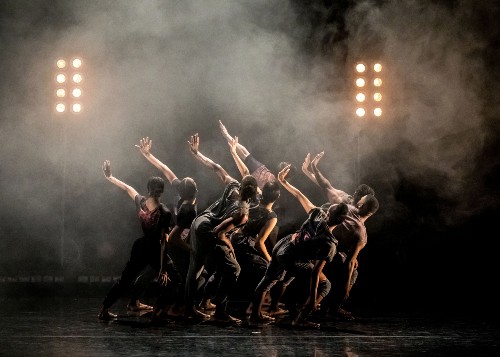
Fineness and flare took the stage along with plenty of technical skill
Harbourfront Centre recently presented A.I.M. as part of Torque, a festival of international contemporary dance. It’s the third time A.I.M. has performed at Harbourfront, and I am kicking myself for missing the previous shows. What a great evening!
A.I.M. performed a mixed repertory of five pieces which together offered a wide-ranging and extremely well-programmed night of dance.
The evening began with an excerpt from Dearest Home, choreographed by A.I.M.’s artistic director Kyle Abraham. The piece is performed in silence by Tamisha Guy and Jae Neal. Two dancers seem to have a push/pull relationship, alternately flirting with and ignoring each other. They repeat a sequence of movements in parallel, but often one is a breath behind the other, creating a fugue. I felt a sense of melancholy – as if they were reaching for something they could not have.
Next up was Show Pony, also by Abraham. Percussive drum accompanied this short solo featuring Marcella Lewis in a metallic unitard. Lewis combines balletic leaps, spins and spirals with body isolations, periodically stopping to admire herself in an imaginary mirror.
Big Rings, choreographed by company member Keerati Jinakunwiphat, closed out the first half of the evening. Big Rings is a fun, inventive group work, influenced by sports and athletics. It was my favourite piece of the night. The score is an eclectic mix, which includes music from Chance the Rapper, The Alan Parsons Project, Camille Saint-Saëns and even a bit from the movie Space Jam.
The six dancers enter one by one wearing sweatpants and hoodies with their names on the back. They seem to be warming up for a game, stretching and bantering with each other. The warm-up transitions to a combination of dance and school gym class, with the dancers moving back and forth across the stage as if they were doing line drills. The movement combines elements of hip hop, contact improvisation, and social dance with innovative lifts and partnering. Although each dancer gets solo moments on stage, Jinakunwiphat creates a real team environment that highlights the dancers’ strength and power.
After the intermission, we were treated to Solo Olos, choreographed by Trisha Brown, one of the giants of modern dance. Originally created in 1976, Solo Olos is an exploration of form and structure. Five dancers in white tops and flowy pants repeat a series of simple movements over and over again in unison. Periodically one of the performers is told to “reverse.” They then rewind their movements and start doing the sequence backwards. This changes the patterns on stage and creates a fascinating interplay between the performers. It’s also incredibly challenging from a technical standpoint as the changes happen rapidly and repeatedly.
The evening closed with Abrahams’s Drive, another big work for the whole company. Set to a thumping score, the work has the dancers flowing in and out from the centre with powerful arms, spins, jumps, and extensions.
I really loved the entire performance. All the dancers in A.I.M. showed strong technical skill and emotional range and depth. I also liked how the evening included a broad spectrum of works – from the very formal, almost severe Solo Olos to the more playful Big Rings. It would be a good accessible introduction for someone who wasn’t familiar with contemporary dance.
Don’t miss A.I.M. next time they are in Toronto. I certainly won’t.
Details:
- A.I.M was presented at the Fleck Dance Theatre at Harbourfront Centre on February 21-22, 2020.
Photo of the company in Drive by Sharen Bradford
